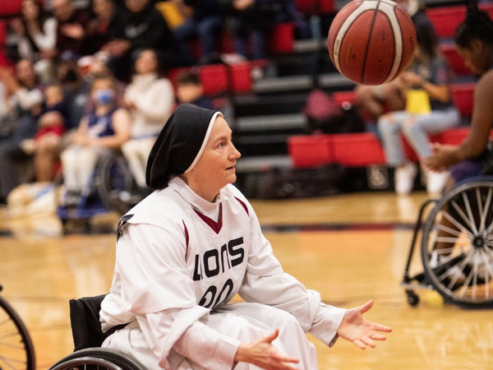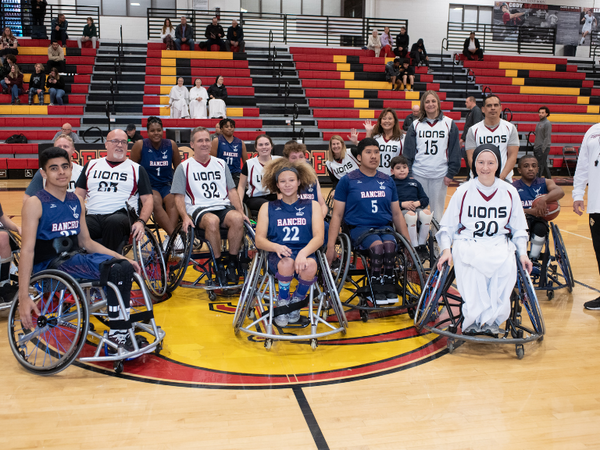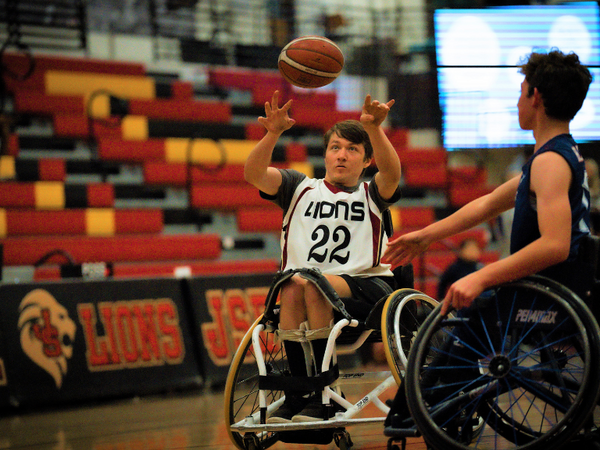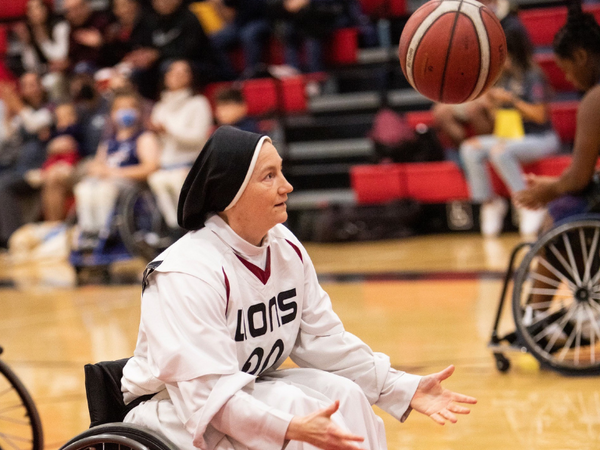An inspired coach on a mission, an exceptional, trail-blazing athlete and a supportive administration are the catalysts behind JSerra Catholic High School’s goal of becoming the first high school in Orange County with a multisport adaptive athletics program.
A successful outcome appears to be more probable than merely possible.
The plan was unknowingly set in motion in early 2022, when twin brothers Keith and Kurt Orahood, longtime tennis coaches at JSerra, started an adaptive wheelchair youth tennis club-program for players with disabilities.
In spring 2022, Keith Orahood, JSerra’s assistant coach under Kurt, was inspired to start an adaptive tennis program to be included with all other Lions’ sports, after coaching then sophomore Landon Sachs, a
wheelchair bound member of the school’s tennis team.
With no adaptive tennis team in place at JSerra at the time, Sachs competed against players with no disabilities under slightly modified rules as permitted by the California Interscholastic Federation, the governing body of high school sports in the state.
In 2022 Sachs competed in his first ever USTA Wheelchair Tournament, finishing first in the 18 and under division. Now a junior, Sachs recently accepted a scholarship to play at the University of Arizona, which offers wheelchair tennis as one of eight adaptive sports.
With an adaptive tennis program now being offered at JSerra, the school administration is looking to establish wheelchair basketball as the Lions’ second adaptive sport.
To bring awareness to adaptive sports in general, JSerra hosted an exhibition wheelchair basketball game on Jan. 21, pitting the nationally known Rancho Halos Junior Wheelchair team from Downey against JSerra teachers and administrators. Sachs was also a member of the JSerra squad.

SR. MARY GABRIEL, A THEOLOGY TEACHER AT JSERRA CATHOLIC HIGH SCHOOL, PREPARES FOR A PASS DURING AN EXHIBITION WHEELCHAIR BASKETBALL GAME HELD ON JAN. 21. PHOTOS BY MELISSA THOMPSON
“It’s pretty nice to get the (adaptive) sports out there and more people playing it and more recognition,” Sachs said. “It’s honestly amazing what (Orahood) has done and what everyone has done.”
Seeing other county schools start adaptive sports would be a dream come true, Sachs added.
“I think eventually it will be that way,” the junior said.
As with most high school and youth sports, money is always an issue and this is especially true for adaptive athletics, where every sport requires its own special wheelchair.
Wheelchairs used for tennis cost about $3,000 each and the chairs for basketball cost $3,500 apiece, Orahood said.
The wheelchairs used by the players on the adaptive tennis squad were donated, he added.
Funding is available through some organizations, including the Challenged Athletes Foundation, which makes significant contributions to adaptive sports and provides players the chance to apply for scholarships for their own chairs.
Because of these funding sources, Orahood expects the size of his adaptive tennis team jump from 10 to about 20 players.
Another challenge is actually finding the athletes interested in participating in adaptive sports, the coach said.
“We network with physical therapists and prosthetic companies and Children’s Health of Orange County (CHOC) and Shriners Hospital to get kids here in Orange County who might see this and say, ‘I can do that,’” Orahood said.
JSerra senior Nicole Griffith also wants to see adaptive sports take off at her school and in the community.
The four-year member of the Lions’ girls tennis team started the JSerra Adaptive Athletics Club with that goal in mind. The club has about 60 students signed up, including about 20 who regularly attend club meetings, Griffith said.
They plan to hold fundraisers for adaptive sports and host more awareness-raising events such as the wheelchair basketball game, she said.
“We’re trying to bring more inclusivity into sports,” Griffith said. “All the sports here … I want to bring an adaptive version of them so that students who live in the area can come here in high school and even if you are in elementary school.”
JSerra athletic director Chris Ledyard was one of the administrators who secured himself into a wheelchair to participate in the basketball game.
Ledyard shares Orahood’s vision of bringing adaptive sports to the school and is thrilled to part of the journey.
The one-sport-at-a-time approach is absolutely the way to make it happen, Ledyard said.
“When you want to pilot any program, you start with one sport,” he said. “You see how it goes. You get a feel for what you fail at and what you are good at and then you expand and to another sport. Keith has been the absolute driving factor. When you look at a lot of pioneering ventures, there is usually one person who made it happen and people eventually start saying I want to be part of that. That is really who Keith has been for us.”



